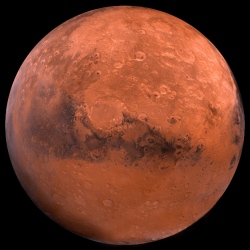
The finding of a ‘cell-like’ structure, which investigators now know once held water, came about as a result of collaboration between scientists in the UK and Greece. Their findings are published in the latest edition of the journal Astrobiology.
While investigating the Martian meteorite, known as Nakhla, Dr Elias Chatzitheodoridis of the National Technical University of Athens found an unusual feature embedded deep within the rock. In a bid to understand what it might be, he teamed up with long-time friend and collaborator Professor Ian Lyon at the University of Manchester.
Professor Lyon, based in Manchester’s School of Earth, Atmospheric and Environmental Sciences, said: “In many ways it resembled a fossilised biological cell from Earth but it was intriguing because it was undoubtedly from Mars. Our research found that it probably wasn’t a cell but that it did once hold water – water that had been heated, probably as a result of an asteroid impact.”
These findings are significant because they add to increasing evidence that beneath the surface, Mars does provide all the conditions for life to have formed and evolved. It also adds to a body of evidence suggesting that large asteroids hit Mars in the past and produce long-lasting hydrothermal fields that could sustain life on Mars, even in later epochs, if life ever emerged there.
